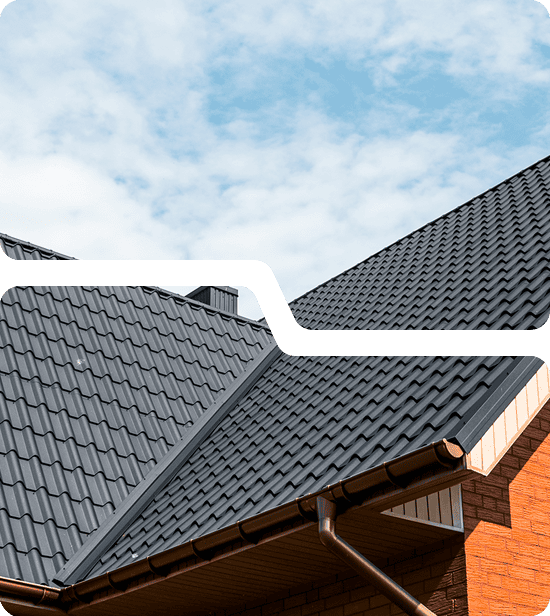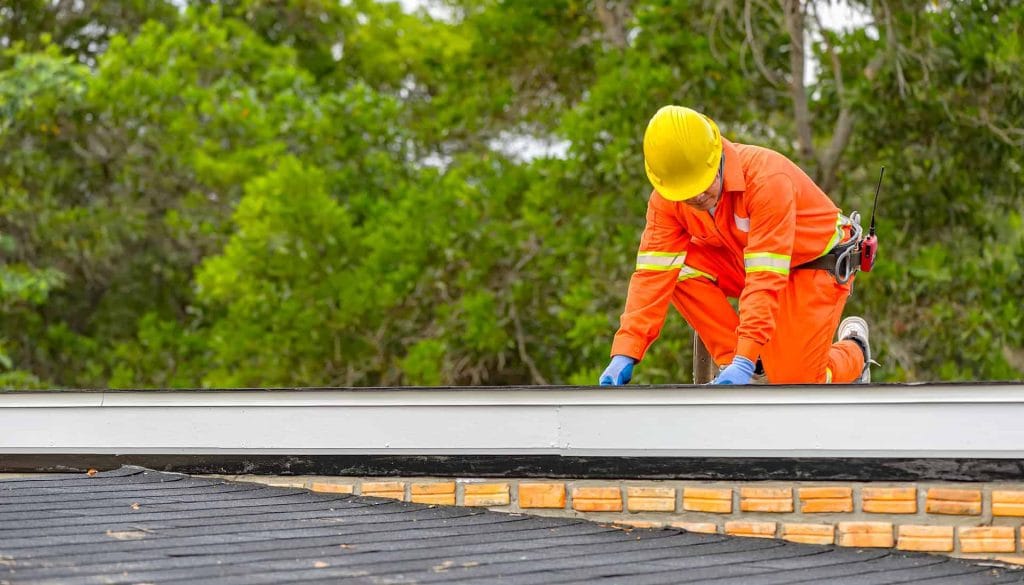The roof of a home is one of its most important features, as it provides protection from the elements and can significantly impact both a house’s aesthetic appeal and energy efficiency. Choosing the right roofing materials for your home should be done with careful consideration; picking the wrong material could have serious implications in terms of cost and safety.
This article will provide tips on how to make an informed decision when selecting roofing materials that are suitable for your home’s needs. It will discuss key factors such as durability, style, costs, maintenance requirements, climate adaptation, and longevity.
By understanding these aspects, readers can make more confident decisions about which type of roofing materials best suits their homes.
Factors To Consider When Choosing Roofing Materials
When selecting the right roofing materials for a home, there are several factors to consider.
Most notably, homeowners should prioritize energy efficiency in their selection process. This is because roofs made of more efficient materials can reduce annual heating and cooling costs, as well as lower air pollution levels due to reduced emissions from HVAC systems.
In addition to energy efficiency, another important factor that homeowners must take into account is the environmental impact of certain roofing materials.
Materials like asphalt shingle or metal may have low upfront costs but can result in negative long-term effects on the environment such as increased waste production or higher carbon dioxide emissions compared to other alternatives such as slate or clay tiles.
Therefore, when deciding upon roofing materials it is essential that one considers both short and long-term impacts while also accounting for budgetary restrictions.

Types Of Roofing Materials
When it comes to selecting the right roofing material, there are a few key factors that should be taken into account. Durability, waterproofing protection and environmental impact, among other considerations, must all be weighed before making a final decision. With this in mind, let’s take a look at some of the various types of materials available for roofs.
One popular option is asphalt shingles which come in either an organic or fiberglass base. The main benefits of asphalt shingles include their cost-effectiveness and relatively easy installation process; however they have limited durability compared to other options such as metal or tile.
Metal is another viable choice when it comes to roofing materials – particularly if you live in an area with heavy rain or snowfall; its low maintenance requirements and superior waterproofing make it ideal for those seeking long-term protection from the elements.
Tile offers excellent protection against water damage but can be expensive due to its weight and difficult installation process. Clay tiles also provide outstanding insulation properties while keeping your home cool during hot summers; however they require regular maintenance and repainting every five years or so.
When considering environmental impact, wood shakes offer great sustainability due to their renewable nature but need frequent maintenance treatments like oil sealers and fungicides to protect them from decay over time.
No matter what type of roofing material you ultimately choose, doing thorough research beforehand will ensure that you select one that meets both your current needs as well as your future goals for protecting your home from weather-related damages.
Durability Of Roofing Materials
The durability of the roofing material chosen for a home is essential. After all, it protects both people and property from extreme weather conditions, fire risks, and more.
When selecting a material for your roof, there are several important considerations to bear in mind. Weather resistance is one of the most important factors when looking at the longevity of a roofing product – exposure to strong winds, hail storms and other harsh elements can cause damage over time if not properly protected.
Fire protection should also be taken into account; some materials offer better insulation against heat than others as well as more reliable performance during wildfires.
It’s worth doing your research before investing in any particular type of roofing material so that you can make an informed decision about which option will best protect you in the long run. Ultimately, this will help ensure that your investment is secure and that your family remains safe and comfortable no matter what Mother Nature throws their way.
Aesthetics Of Roofing Materials
The aesthetics of roofing materials are just as important to consider when selecting the right option for your home. Aesthetics can be determined by color schemes and texture options, all of which must work in harmony with the surrounding environment to create a visually appealing result.
Many homeowners opt for natural colors, such as earth tones that blend well into their landscape. Others may choose bolder shades that stand out from traditional hues or complement existing elements on their property. Additionally, some materials offer more texture options than others, such as wood shakes or stone coated steel panels that bring an added dimension of depth to the overall look and feel.
No matter what aesthetic you decide upon, carefully considering it can make a huge difference in both curbside appeal and resale value.
When deciding on the best roofing material for your home’s exterior design needs, think about how each type available will fit into overall color scheme and various textures offered. You want something that looks great and adds value to your house while also protecting it against weather conditions like rain, snow, wind and hail damage.
Ultimately, it is essential to take time researching different types of roofing systems so you can make an informed decision and select one that meets all your requirements accordingly.
Maintenance Requirements For Different Roofing Materials
When making the decision to re-roof a home, it is important to consider the environmental impact of roofing materials along with their installation process.
Asphalt shingles are one of the most popular and cost effective options for residential roofs due to their durability and variety in color and texture. However, asphalt shingles have a relatively short lifespan compared to other roofing materials such as metal or wood shakes which can last up to 50 years if properly installed and maintained.
Metal roofs offer superior longevity when compared to asphalt shingles but require specialized installation processes that may be more expensive than traditional asphalt shingle methods.
Wood shakes provide an aesthetically pleasing alternative while providing moderate levels of protection from weather elements; however they require regular maintenance over time due to susceptibility to rot, mold, and mildew growth.
Ultimately, selecting the right roofing material depends on factors like budget, desired aesthetic appeal, environmental requirements, and installation difficulty. Homeowners should carefully consider each factor before committing to any particular type of roof for long term use.
Understanding how different types of roofing materials install and maintain will help guide homeowners towards the best choice for their own individual needs.
Costs Of Roofing Materials
The cost of roofing materials is an important consideration when selecting the right material for a home. It is important to compare prices before making a selection, as certain materials may require more maintenance or have higher installation costs than others.
Additionally, it is wise to consider factors such as energy efficiency and durability when weighing the cost-benefit analysis of various options.
Before making any purchasing decisions, homeowners should review the pros and cons associated with each type of material they are considering. For example, asphalt shingles offer affordability but can be vulnerable to wear and tear; while tile roofs provide greater protection against heat loss but tend to be more expensive initially.

Taking into account both short and long term expenses can help determine which option will ultimately save money in the end.
Climate Adaptation Of Roofing Materials
The roof of your house serves as a shield against the elements, protecting you and your family from rain, wind, snow, hail, and other inclement weather. But not all roofs are created equal; selecting the right material is key to ensuring that your home remains safe during extreme weather conditions.
To ensure superior weatherproofing and storm resistance while adapting to any climate, homeowners should consider these options when choosing their roofing materials.
Asphalt shingles have long been a popular choice for cost-effective yet durable protection against nature’s worst. Asphalt provides excellent insulation that helps keep energy costs down in hot climates or cold climates alike. It is also highly resistant to winds up to 130 mph and can be easily maintained over time with regular cleaning and repairs.
Metal roofs provide an even more durable solution for those looking for top-of-the-line storm resistance without sacrificing style. Available in several colors, metal roofs offer superior fire safety ratings along with unbeatable protection against heavy rains and high winds—all at an affordable price point compared to other types of roofing materials.
Regardless of which type of roof material you choose for your home, it’s important to select one that offers optimal protection in order to maximize its lifespan and protect your investment into the future.
Conclusion
When selecting roofing materials for a home, it is important to keep in mind the various factors such as durability, aesthetics, maintenance requirements and costs.
It is also necessary to consider climate adaptation when making a decision regarding roofing materials.
Taking all of these elements into consideration will ensure that an effective and suitable choice is made for the property.
Furthermore, it may be beneficial for homeowners to research their options thoroughly before committing to any particular material.
This can help them make well-informed decisions about which type of roofing material would best suit their needs and budget.














